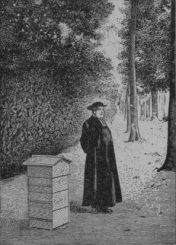
Warré plans
Warré methods
Warré modifications
Warré precursors
Groups / Fora
Google
e-group
Biobees.com
forum
Abbé Warré's book
Beekeeping for All:
Precursors of the People's Hive of Abbé Emile Warré
The fundamental concept on which Warré based his hive is not new and Warré himself acknowledged this on pages 146-9 of his book Beekeeping For All1.
It has so far been possible to identify the following people in France, Sweden, Germany, England and Russia who, prior to Warré, developed hives along similar or identical principles and published the results:
John Gedde (1647-1697), book published 1677 (3rd edition).
Guillaume Louis Formanoir de Palteau (1712-?), book published in 1756.
Samuel Linnaeus (1718-1797), book published in 1768
Thomas Wildman (1734-1781), book published 1768
Pfarrer Johann Ludwig Christ (1739-1813), book published in 1779.
Bryan I'Anson Bromwich (? - 1805), book published in 1783.Pierre Louis Du Couédic de Villeneuve (1743-1822), book published in 1813.
Edward Bevan (1770-1860), book published in 1827.
T. M. Howatson (?-?), book published in 1827.
Nicolai Vitvitsky (1764-1853), book first published in 1846
Illarion Semenovich Kullanda (1848-1922); book published in 1882; a near precursor of Warré
The fact that these are all apparently independent inventions supports the soundness of the principle on which beekeeping with these hives is based. All the hives comprise stacks of hive-body elements to which new elements are added at the bottom in the spring and from which honey is removed from the top element(s) in the autumn. The hives of Warré, Bevan, Howatson and Christ are vertical (or tiered or storified) top-bar hives. The divisions between the boxes of the Palteau and Du Couédic hives comprise perforated boards, the former with a large hole in the centre to allow central combs to continue unbroken from box to box, the latter with only one small hole in the centre. The hive described by von Linné is a skep storified with rings in which the comb is partly supported on spales.
To the above we can also add the hive still used for Apis cerana in Japan which has been in use for several hundred years.
One peculiarity of the People's Hive is its quilt (coussin in French) which comprises a 100 mm deep frame, the same size as the boxes below, with a cloth tacked to its underside and filled with some natural insulating material such as chopped straw, dry leaves or wood shavings etc. Warré halso had precursors among beekeepers who recommended a similar device (please see our page on the quilt).
Reference
1) Émile Warré, Beekeeping For All, 2010, trans. from L'Apiculture Pour Tous, (12th ed. 1948) Northern Bee Books. PDF available (see link on left).